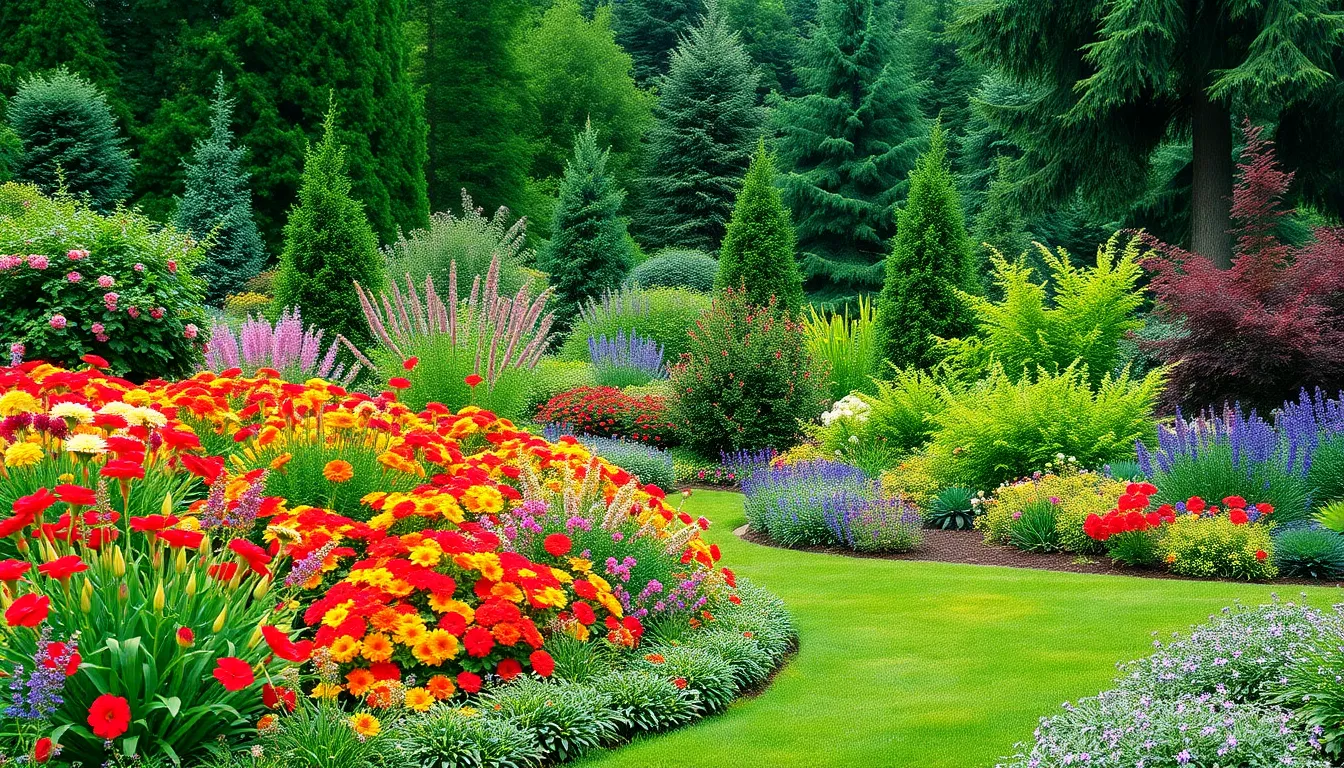Transforming a yard into a stunning landscape doesn’t require a degree in botany or a trust fund. With the right plants, anyone can create a vibrant outdoor space that even the neighbors will envy. From low-maintenance perennials to eye-catching shrubs, the world of landscaping plants is full of options that can make any garden flourish.
Plants For Landscaping
Transforming yards with plants provides numerous advantages. A well-planned landscape enhances a property’s value while creating inviting outdoor spaces.
Aesthetic Appeal
Visually pleasing landscapes attract attention and admiration. Plants introduce color, texture, and form, making environments more attractive. Flowering plants add seasonal interest, while evergreen varieties provide year-round beauty. Careful selection of plants allows for a cohesive design that complements architecture. Utilizing contrasting foliage creates depth, enhancing visual appeal. Borders, pathways, and focal points help guide the eye through the landscape, encouraging exploration.
Environmental Impact
Landscaping with plants offers significant ecological benefits. Plants improve air quality by absorbing carbon dioxide and releasing oxygen. They provide natural habitats for birds, insects, and other wildlife, promoting biodiversity. Roots stabilize the soil, preventing erosion and enhancing water retention. Landscaped areas reduce urban heat by lowering temperatures through shade and evapotranspiration. Choosing native plants supports local ecosystems, reducing the need for water and chemical fertilizers. Incorporating plants in landscapes fosters a healthier environment for communities and wildlife.
Types Of Plants For Landscaping


Various plant types significantly enhance landscaping designs, each contributing uniquely to outdoor aesthetics.
Flowers
Flowers offer vibrant colors and varying shapes, making them essential in landscaping. Popular choices include roses, daisies, and lilies, known for their visual appeal. Seasonal blooms, such as tulips in spring and chrysanthemums in fall, create dynamic displays. Flowers attract pollinators, promoting biodiversity and supporting local ecosystems. Choose perennial flowers for long-lasting beauty; they return year after year with minimal effort.
Shrubs
Shrubs serve as versatile landscaping elements, providing structure and privacy. Options like boxwood and hydrangea thrive in different conditions, fitting various landscape designs. Low-maintenance varieties, such as junipers and barberries, require less care while maintaining an attractive appearance. Shrubs can act as borders or foundation plants, enhancing the overall design. Evergreen shrubs ensure year-round greenery, supporting aesthetic appeal in every season.
Trees
Trees play a crucial role in landscaping, offering shade, privacy, and visual interest. Varieties like maple and oak provide stunning fall colors, while evergreens like pine offer year-round coverage. Choosing native trees enhances ecological sustainability, supporting local wildlife. Establishing a tree canopy improves air quality and reduces urban heat. Trees create focal points, enhancing the landscape’s overall structure and harmony.
Groundcovers
Groundcovers fill empty spaces, preventing soil erosion and suppressing weeds. Choices like creeping thyme and sedum thrive in various conditions, ensuring lush greenery without much upkeep. Fast-growing groundcovers can quickly cover areas, adding texture and color. They work well in shaded or sunny spots, providing flexibility in landscaping designs. Using groundcovers promotes a cohesive look, integrating seamlessly into flower beds and borders.
Choosing The Right Plants For Your Landscape
Selecting appropriate plants is essential to achieving a successful landscape design. Understanding different factors helps ensure the best results.
Climate Considerations
Climate plays a crucial role in plant selection. Different plants thrive in varying climatic conditions, affecting growth and longevity. For instance, regions with high humidity often suit tropical plants like hibiscus and ferns, while arid areas favor drought-resistant species like succulents and lavender. Homeowners should consider local hardiness zones, as these indicate which plants will survive winter temperatures. Additionally, factors like rainfall patterns and sunlight exposure influence plant health and maintenance. Integrating climate-appropriate plants enhances overall landscape resilience.
Soil Type
Soil type significantly impacts plant growth and establishment. Healthy soil contributes directly to plants’ success in landscaping. Sandy soils drain quickly and may require drought-tolerant plants such as ornamental grasses. Clay soils hold moisture but can suffocate roots; therefore, choosing moisture-loving plants like irises may be beneficial. Furthermore, loamy soils balance drainage and retention, accommodating a wider variety of plants. Conducting a soil test provides essential information about pH levels and nutrient content, guiding homeowners in selecting compatible plants for their landscape.
Maintenance Tips For Landscaping Plants
Maintaining landscaping plants ensures a vibrant and healthy outdoor space. Regular care enhances the aesthetic appeal and longevity of plants.
Watering Techniques
Watering plays a crucial role in plant health. Deep watering encourages root growth, making plants more resilient. Morning remains the best time to water, allowing foliage to dry before evening. Using soaker hoses or drip irrigation can efficiently deliver moisture directly to roots. Avoid watering too frequently to prevent root rot. Observing soil moisture levels helps determine when to water, ensuring plants receive ample hydration.
Pruning and Fertilizing
Pruning encourages healthy growth and enhances plant shape. Regularly removing dead or damaged branches helps prevent disease spread. Spring becomes the ideal time for most trimming tasks. Fertilizing provides essential nutrients to plants, promoting vigorous growth. Opting for slow-release fertilizers ensures a steady nutrient supply over time. Testing soil nutrient levels allows for targeted fertilization, meeting specific plant needs. Combining these practices fosters a thriving landscape that captivates the eye.

